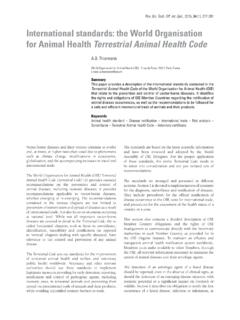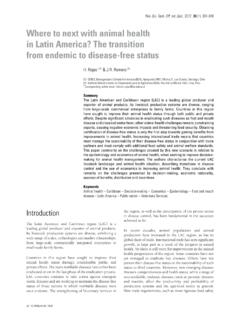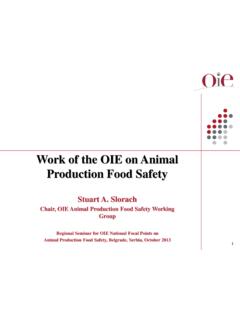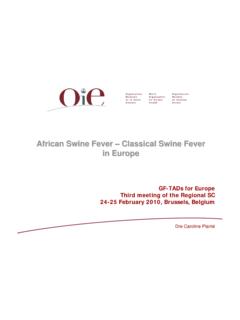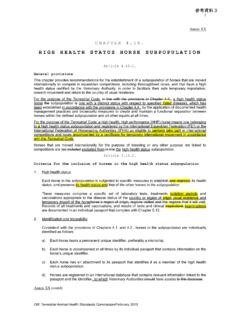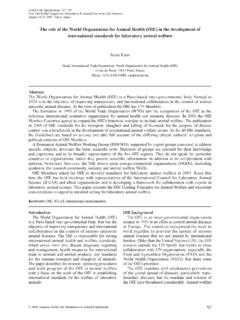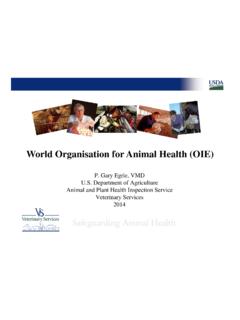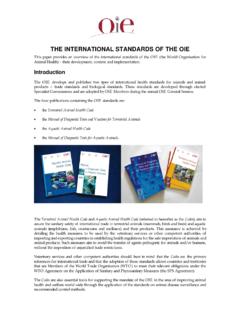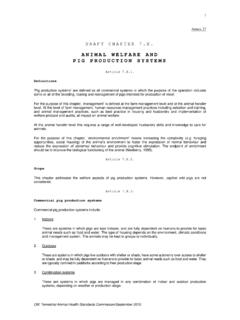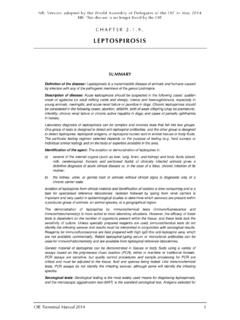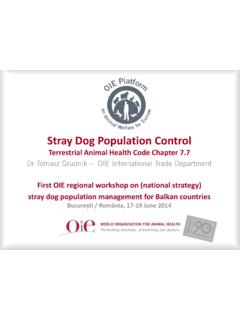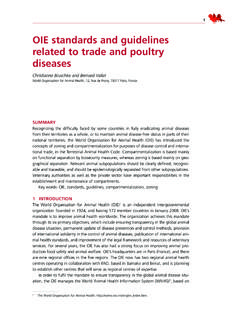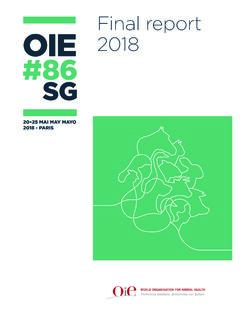Transcription of Integrating animal health and foodborne disease surveillance
1 Rev. sci. tech. Off. int. Epiz., 2013, 32 (2), 337-346 Integrating animal health and foodborne disease Berman (1)* & A. Shimshony (2)(1) Israel Veterinary Services, Box 12, Beit-Dagan, 50250, Israel (2) Box 13327, Tel Aviv 61132, Israel*Corresponding author: control of foodborne diseases from an animal source has become an important part of public health policy. Since the agents that cause these diseases originate in animals, Veterinary Services, as well as Public health Services, must be involved in their control. Control programmes should be established either through cooperation between the two Services or by the consolidation of all those involved into a single food control agency.
2 surveillance is an important part of these control following questions must be addressed when planning an effective surveillance programme. What is the relative incidence, morbidity, mortality and economic cost of the foodborne disease in humans? Is the animal population the exclusive or a significant source of the human foodborne infection? What kind of surveillance is needed to identify the disease -causing agent in the animal population? Are we interested in identifying all cases of a disease in order to eradicate it or is our aim to reduce its incidence in the animal population? Do we have the ability to control the disease in the animal population?
3 What disease detection tests are available? What are the sensitivity, specificity and cost of these diagnostic tests? Finally, does the country, region or agency involved have the legal, financial and educational resources to carry out this surveillance and follow it up with appropriate action? After these questions have been resolved, the veterinary and public health sectors must jointly decide if surveillance and control are feasible. If so, they can then begin to develop an appropriate zoonosis Public health 1971, the World Organisation for animal health (OIE) published the second edition of the terrestrial animal health Code (which at that time was know as the International Zoo-sanitary Code).
4 It listed 43 diseases, of which only three were foodborne zoonoses: brucellosis, bovine tuberculosis and trichinosis. The word zoonoses did not appear in the glossary of this edition of the terrestrial Code and its preface stated: This Code has been established with a view to working out, in the general interest, a common doctrine of protection of the national livestocks against the spread of the epizootics which threaten all the Regions of the World (29). No mention was made of public health or the 2012 OIE list of notifiable diseases there are 90 disease entities, 30 of them zoonotic, of which 13 are foodborne zoonotic diseases (32). In the 2012 edition of the terrestrial Code, the word zoonoses appears in the glossary, and the foreword states: The oie terrestrial animal health Code ( terrestrial Code) sets out standards for the improvement of terrestrial animal health and welfare and veterinary public health worldwide.
5 In addition, this edition of the terrestrial Code includes sections on veterinary public health and surveillance (33).While animal health has always been the traditional task of veterinarians and Veterinary Services, in recent decades the prevention of foodborne diseases from an animal source has become a primary objective of the food-producing sectors 338 Rev. sci. tech. Off. int. Epiz., 32 (2)of national Veterinary Services, hence these changes in the oie terrestrial animal producers are primarily interested in the health of their animals as it affects their production parameters and profits, and are less interested in public health aspects. Unless these public health diseases are also an animal health problem or national or regional regulations require them to take certain actions, control or eradication of these diseases will not be a major concern of a result of these changes there must be integration or at least close collaboration between the Veterinary Services and Public health Services of a country or region.
6 In some countries, food agencies have been established which combine the food-producing sectors of the Ministries of Agriculture and health . In other countries, these Ministries act independently and, where necessary, collaborate to integrate their policies. This integration also applies to surveillance programmes, both passive and active, which form the basis of animal and human disease control review is restricted to general surveillance policies specific to foodborne diseases from an animal source. For further information, the reader is referred to Chapter of the 2012 edition of the terrestrial Code, animal health surveillance , in which the specifics of animal health surveillance programmes are discussed.
7 surveillance of foodborne diseases in the human population is also necessary, to help determine priorities in animal disease paper will not be an exhaustive review of all foodborne animal diseases, but will rather give examples of surveillance of these diseases in the animal population, to illustrate the factors that must be taken into consideration when planning an integrated surveillance of foodborne diseases of animal originFor the purposes of this paper, animal diseases can be divided into four groups: diseases that are mainly an animal health problem, but can have foodborne public health implications (it is in the producer s primary interest to prevent diseases like this) diseases that are both an animal health problem and a foodborne public health problem diseases that are primarily or only a public health consideration as foodborne infections in humans and rarely cause disease in animals diseases that are only an animal health problem and have no public health that are mainly an animal health problemAn example of a foodborne zoonosis originating in poultry that can have foodborne public health implications is highly pathogenic avian influenza (HPAI)
8 Due to H5N1. While H5N1 is not primarily a foodborne pathogen, the consumption of undercooked poultry has been implicated as a possible source of transmission (4) and many countries have put regulations into place that assume this method of transmission. Highly pathogenic avian influenza (H5N1) in commercial poultry is usually identified by its acute onset and high mortality or drop in egg production. Therefore, active surveillance might not be necessary. Passive surveillance , through compulsory reporting of suspected and diagnosed cases, is usually enough to identify these cases. On the other hand, low pathogenicity avian influenza (LPAI) (H5N1) can circulate in all poultry types with few or no clinical signs and, at some point, mutate to a highly pathogenic virus (23).
9 In commercial water fowl, HPAI (H5N1) can be subclinical (24). For these cases active surveillance would be the mammalian realm, a somewhat similar situation is found with Q fever in goats. The pathogen is abortifacient. Mass abortions in goats, causing serious economic losses, lead to the need for vaccination. The causative agent of Q fever, Coxiella burnetii, can infect humans by the airborne route. Contamination of animal products, mainly milk and dairy products, may occur, since infected females can shed C. burnetii in their milk for several months, even over several milking seasons (3). Active surveillance in goats will not help in reducing the infection rate in humans.
10 It is in the producer s primary interest to prevent such significant that are both an animal health and foodborne public health problemParatyphoid Salmonella, including Salmonella Enteritidis and S. Typhimurium, cause a disease that poses a health risk for both humans and animals (particularly poultry). Each of these bacteria can cause serious clinical disease in young poultry, but rarely in mature poultry. On the other hand, poultry of all ages are often carriers of Salmonella without any clinical signs and also without any influence on production parameters (13). In humans, paratyphoid Salmonella is one of the most common causes of bacterial enteritis, often being caused by infected poultry and other foods from animal sources (7).
